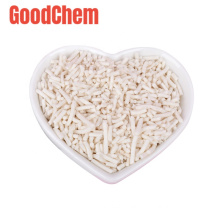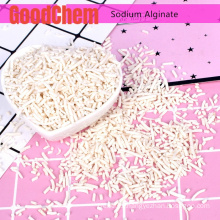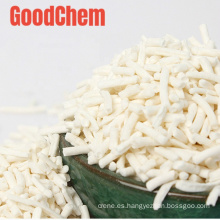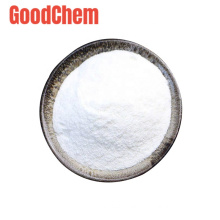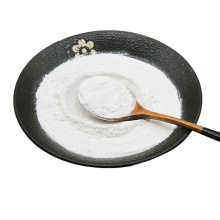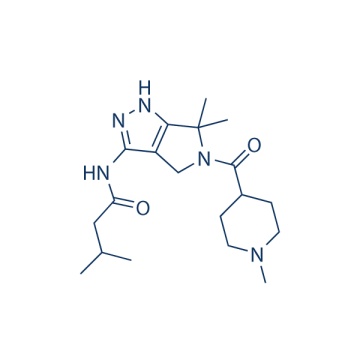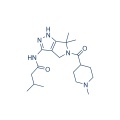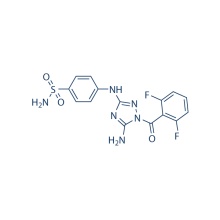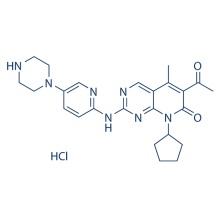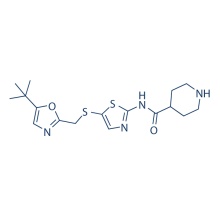.cp_wz tabla {borde superior: 1px sólido #ccc; borde izquierdo: 1px sólido #ccc; } .cp_wz table td {borde derecho: 1px sólido #ccc; borde inferior: 1px sólido #ccc; padding: 5px 0px 0px 5px;} .cp_wz table th {border-right: 1px solid #ccc; border-bottom: 1px solid #ccc; padding: 5px 0px 0px 5px;} \ n Peso molecular: \ n 361.48 PHA-793887 es un inhibidor novedoso y potente de CDK2, CDK5 y CDK7 con IC50 de 8 nM, 5 nM y 10 nM. Es más de 6 veces más selectivo para CDK2, 5 y 7 que CDK1, 4 y 9. Fase 1. \ n Actividad biológica PHA-793887 tiene baja actividad contra CDK1, CDK4, CDK9 y GSK3β con IC50 de 60 nM , 62 nM, 138 nM y 79 nM, respectivamente. PHA-793887 inhibe la proliferación celular de muchas líneas de células tumorales, incluidas A2780, HCT-116, COLO-205, C-433, DU-145, A375, PC3, MCF-7 y BX-PC3, con IC50 de 88 nM– 3,4 µM. PHA-793887 (1 μM) muestra una disminución en la fase S, un aumento posterior de la fase G1 y una ligera acumulación de fase G2 / M en las células A2780. PHA-793887 (3 μM) aumenta significativamente la fase G2 / M y reduce la síntesis de ADN. PHA-793887 es citotóxico para líneas celulares leucémicas, incluidas K562, KU812, KCL22 y TOM1, con IC50 de 0.3 a 7 μM, pero no es citotóxico para células mononucleares de sangre periférica no estimuladas normales o células madre hematopoyéticas CD34 +. En los ensayos de colonias, PHA-793887 muestra una actividad muy alta contra las líneas celulares de leucemia con IC50 inferior a 0,1 µM. PHA-793887 induce la detención del ciclo celular, inhibe la fosforilación de Rb y nucleofosmina, y modula la expresión de ciclina E y cdc6 a 0,2-1 μM e induce apoptosis a 5 μM. PHA-793887 (10-30 mg / kg) muestra una buena eficacia en los modelos de xenoinjerto de carcinoma de ovario humano A2780, colon HCT-116 y pancreático BX-PC3. PHA-793887 (20 mg / kg) es eficaz en modelos de xenoinjerto de células K562 y HL60, modelo diseminado de leucemia primaria y un modelo de ALL-2 diseminado de alta carga derivado de un paciente con leucemia linfoide aguda Filadelfia positiva en recaída. Protocolo (solo como referencia) Ensayo de quinasa: [3]
|
CDK Kinase Assay
|
The biochemical activity of compounds is determined by incubation with specific enzymes and substrates, followed by quantitation of the phosphorylated product. PHA-793887 (1.5 nM–10 μM) is incubated for 30−90 min at room temperature in the presence of ATP/33P-γ-ATP mix, substrate, and the specific enzyme (0.7−100 nM) in a final volume of 30 μL of kinase buffer, using 96 U bottom plates. After incubation, the reaction is stopped and the phosphorylated substrate is separated from nonincorporated radioactive ATP using SPA beads, Dowex resin, or Multiscreen phosphocellulose filter as follows: (1) For SPA Assays. The reaction is stopped by the addition of 100 μL of PBS + 32 mM EDTA + 0.1% Triton X-100 + 500 μM ATP, containing 1 mg of streptavidin-coated SPA beads. After 20 min of incubation for substrate capture, 100 μL of the reaction mixture is transferred into Optiplate 96-well plates containing 100 μL of 5 M CsCl, left to stand for 4 hours to allow stratification of beads to the top of the plate, and counted using TopCount to measure substrate-incorporated phosphate. (2) For Dowex Resin Assay. An amount of 150 μL of resin/formate, pH 3.00, is added to stop the reaction and capture unreacted 33P-γ-ATP, separating it from the phosphorylated substrate in solution. After 60 min of rest, 50 μL of supernatant is transferred to Optiplate 96-well plates. After the additon of 150 μL of Microscint 40, the radioactivity is counted in the TopCount. (3) For Multiscreen Assay. The reaction is stopped with the addition of 10 μL of EDTA (150 mM). An amount of 100 μL is transferred to a MultiScreen plate to allow substrate binding to phosphocellulose filter. Plates are then washed three times with 100 μL of H2PO4 (75 mM) filtered by a MultiScreen filtration system, and dried. After the additon of 100 μL of Microscint 0, radioactivity is counted in the TopCount.
IC50 values are obtained by nonlinear regression analysis.
|
Ensayo celular: [1]
|
Cell lines
|
A2780 cells
|
|
Concentrations
|
0.1 nM-1 μM, dissolved in DMSO
|
|
Incubation Time
|
72 hours
|
|
Method
|
Cells are seeded into 96- or 384-wells plates at final concentration ranging from 1 × 104 to 3 × 104 per cm2. After 24 hours, cells are treated using serial dilution of PHA-793887. At 72 hours after the treatment, the amount of cells are evaluated using the CellTiter-Glo assay. IC50 values are calculated using a sygmoidal fitt
|
Estudio con animales: [1]
|
Animal Models
|
Mouse xenograft models of human ovarian A2780, colon HCT-116 and pancreatic BX-PC3 carcinoma
|
|
Formulation
|
Dissolved in 5% dextrose solution
|
|
Dosages
|
10, 20, and 30 mg/kg
|
|
Administration
|
Intravenous injection once daily
|
|
Solubility
|
30% propylene glycol, 5% Tween 80, 65% D5W,
15 mg/mL
|
|
* Please note that Selleck tests the solubility of all compounds in-house, and the actual solubility may differ slightly from published values. This is normal and is due to slight batch-to-batch variations.
|
Conversión de diferentes modelos de animales basados en BSA (valor basado en datos del Borrador de Directrices de la FDA)
|
Species
|
Baboon
|
Dog
|
Monkey
|
Rabbit
|
Guinea pig
|
Rat
|
Hamster
|
Mouse
|
|
Weight (kg)
|
12
|
10
|
3
|
1.8
|
0.4
|
0.15
|
0.08
|
0.02
|
|
Body Surface Area (m2)
|
0.6
|
0.5
|
0.24
|
0.15
|
0.05
|
0.025
|
0.02
|
0.007
|
|
Km factor
|
20
|
20
|
12
|
12
|
8
|
6
|
5
|
3
|
|
Animal A (mg/kg) = Animal B (mg/kg) multiplied by
|
Animal B Km
|
|
Animal A Km
|
Por ejemplo, para modificar la dosis de resveratrol utilizada para un ratón (22,4 mg / kg) a una dosis basada en el BSA para una rata, multiplique 22,4 mg / kg por el factor Km para un ratón y luego divida por el factor Km para una rata. Este cálculo da como resultado una dosis equivalente para ratas de resveratrol de 11,2 mg / kg.
|
Rat dose (mg/kg) = mouse dose (22.4 mg/kg) ×
|
mouse Km(3)
|
= 11.2 mg/kg
|
|
rat Km(6)
|
Información química
|
Molecular Weight (MW)
|
361.48
|
|
Formula
|
C19H31N5O2
|
|
CAS No.
|
718630-59-2
|
|
Storage
|
3 years -20℃Powder
|
|
6 months-80℃in solvent (DMSO, water, etc.)
|
|
Synonyms
|
|
|
Solubility (25°C) *
|
In vitro
|
DMSO
|
72 mg/mL
(199.18 mM)
|
|
Water
|
<1 mg/mL
(
|
|
Ethanol
|
72 mg/mL
(199.18 mM)
|
|
In vivo
|
30% propylene glycol, 5% Tween 80, 65% D5W
|
15 mg/mL
|
* <1 mg/ml means slightly soluble or insoluble.
* Please note that Selleck tests the solubility of all compounds in-house, and the actual solubility may differ slightly from published values. This is normal and is due to slight batch-to-batch variations.
|
|
Chemical Name
|
N-(6,6-dimethyl-5-(1-methylpiperidine-4-carbonyl)-1,4,5,6-tetrahydropyrrolo[3,4-c]pyrazol-3-yl)-3-methylbutanamide
|
Calculadora de molaridad Calculadora de dilución Calculadora de peso molecular
Grupos de Producto : Ciclo celular > Inhibidor de CDK
